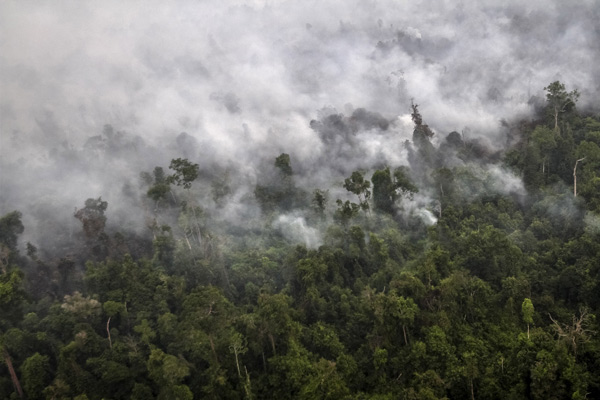 |
|
A forest fire is seen from a helicopter operated by the National Agency for Disaster Management (BNPB) over Langgam District, Riau province on the island of Sumatra in this Sept 23, 2015 file photo taken by Antara Foto. [Photo/Agencies] |
UNITED NATIONS - The World Meteorological Organization (WMO) on Monday warned that the amount of greenhouse gases in the atmosphere reached another record high in 2014.
"According to the latest Greenhouse Gas Bulletin, since 1990 there has been a 36 percent increase in radiative forcing -- the warming effect on our climate -- because of greenhouse gases such as carbon dioxide, methane and nitrous oxide from industrial, agricultural and domestic activities," UN spokesman Stephane Dujarric said at a daily news briefing here.
The WMO's Greenhouse Gas Bulletin, released ahead of the UN climate conference this December in Paris, also highlighted the interaction and amplification effect between rising levels of CO2 and water vapor, which is itself a major greenhouse gas, albeit short-lived. Warmer air holds more moisture and so increased surface temperatures caused by CO2 would lead to a rise in global water vapor levels, further adding to the enhanced greenhouse effect.
The WMO noted that further increases in CO2 concentrations will lead to disproportionately high increases in thermal energy and warming from water vapor.
Meanwhile, the study showed that atmospheric concentrations of CO2 -- the most important long-lived greenhouse gas -- reached 397.7 parts per million (ppm) in 2014. In the Northern hemisphere, CO2 concentrations crossed the symbolically significant 400 ppm level in 2014 spring, when CO2 is most abundant. In spring 2015, the global average concentration of CO2 crossed the 400 ppm barrier.
"We will soon be living with globally averaged CO2 levels above 400 parts per million as a permanent reality," WMO Secretary-General Michel Jarraud said in a press release. "We can't see CO2. It is an invisible threat, but a very real one."
"It means hotter global temperatures, more extreme weather events like heatwaves and floods, melting ice, rising sea levels and increased acidity of the oceans," said the head of the UN weather agency. "This is happening now and we are moving into unchartered territory at a frightening speed."
"Excess energy trapped by CO2 and other greenhouse gases is heating up the Earth surface which leads to increase in atmospheric water vapor which in turn is generating [and] trapping even more heat," he added, underlining that carbon dioxide has remained in the atmosphere for hundreds of years and in the ocean for even longer.
"Past, present and future emissions will have a cumulative impact on both global warming and ocean acidification. The laws of physics are non-negotiable," Jarraud said.
The WMO's Greenhouse Gas Bulletin reports on atmospheric concentrations -- and not emissions -- of greenhouse gases. Emissions represent what goes into the atmosphere while concentrations represent what remains in the atmosphere after the complex system of interactions between the atmosphere, biosphere, cryosphere and the oceans.
According to the WMO, about a quarter of the total emissions is taken up by the oceans and another quarter by the biosphere, reducing in this way the amount of CO2 in the atmosphere.
"Every year we report a new record in greenhouse gas concentrations," Jarraud said. "Every year we say that time is running out. We have to act now to slash greenhouse gas emissions if we are to have a chance to keep the increase in temperatures to manageable levels."